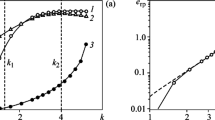Abstract
The cohesive crack is a useful model for describing a wide range of physical situations from polymers and ceramics to fiber and particle composite materials. When the cohesive zone length is of the order of the specimen size, the influence method—based on finite elements—may be used to solve the fracture problem. Here a brief outline of an enhanced algorithm for this method is given. For very large specimen sizes, an asymptotic analysis developed by the authors allows an accurate treatment of the cohesive zone and provides a powerful framework for theoretical developments. Some recent results for the zeroth order and first order asymptotic approaches are discussed, particularly the effective crack concept and the maximum load size effect. These methods are used to analyze the effect of the size and of the shape of the softening curve on the value at the peak load of several variables for three point bent notched beams. The results show, among other things, that for intermediate and very large sizes the size effect curves depend strongly on the shape of the softening curve, and that only the simultaneous use of asymptotic and influence methods may give an adequate estimate of the size effect in the intermediate range.
Similar content being viewed by others
References
G.I. Barenblatt, Journal of Applied Mathematics and Mechanics 23 (1959) 622–636.
D.S. Dugdale, Journal of Mechanics and Physics of Solids 8 (1960) 100–104.
Z.P. Bazant, Journal of Engineering Mechanics, ASCE 110 (1984) 518–538.
Z.P. Bazant, Applied Mechanics Reviews 39 No 5 (1986) 675–705.
J.N. Goodier, in Fracture, an Advanced Treatise, Vol. 2, H. Liebowitz (ed.), Academic Press, New York (1968) 1–66.
T. Ungsuwarungsri and W.G. Knauss, ASME Journal of Applied Mechanics 55 (1988) 44–58.
S.J. Bennison and B.R. Lawn, Acta Metallurgica 37 No 10 (1989) 2659–2671.
A. Hillerborg, M. Modeer and P.E. Petersson, Cement and Concrete Research 6 (1976) 773–782.
P.E. Petersson, Crack Growth and Development of Fracture Zones in Plain Concrete and Similar Materials, Report TVBM 1006, University of Lund, Sweden (1981).
Z.P. Bazant, Cement and Concrete Research 17 (1987) 951–967.
M. Ortiz, International Journal of Solids and Structures 24 (1988) 231–250.
H. Horii, A. Hasenaga and F. Nishino, Preprints, SEM-RILEM International Conference on Fracture of Concrete and Rock, Society for Experimental Mechanics, Bethel CT 6801, USA (1987) 299–307. Also in Fracture of Concrete and Rock. S.P. Shah and S.E. Swarts (eds.), Springer Verlag, New York (1989) 205–219.
H. Horii, S. Zihai and S-X Gong, in Cracking and Damage, Strain Localization and Size Effect, J. Mazars and Z.P. Bazant (eds.), Elsevier Applied Science, London (1989) 104–115.
M. Elices and J. Planas, in Fracture Mechanics of Concrete Structures: From Theory to Applications, L. Elfgren (ed.), Chapman and Hall, London (1989) 16–66.
A. Hillerborg and J. Rots, in Fracture Mechanics of Concrete Structures: From Theory to Applications, L. Elfgren, ed., Chapman and Hall, London (1989) 128–146.
J.L. Lorca, J. Planas and M. Elices, in Fracture of Concrete and Rock: Recent Developments. S.P. Shah, S.E. Swartz and B. Barr (eds.), Elsevier Applied Science, London (1989) 357–368.
J. Planas and M. Elices, Anales de Mecánica de la Fractura 3 (1986) 219–227.
J. Planas and M. Elices, A new method of asymptotic analysis of the development of a cohesive crack in mode I loading. Report 87–02 Depto. de Ciencia de Materiales, Universidad Politécnica de Madrid, Spain (1987).
J. Planas and M. Elices, International Journal of Fracture (1992).
J. Planas and M. Elices, in Fracture Toughness and Fracture Energy of Concrete, F.H. Wittmann (ed.), Elsevier Science, Amsterdam (1986) 381–390.
J. Planas and M. Elices, in Cracking and Damage, Strain Localization and Size Effect. J. Mazars and Z.P. Bazant (eds.), Elsevier Applied Science, London (1989) 462–476.
J. Planas and M. Elices, Engineering Fracture Mechanics 35 No 1/2/3 (1990) 87–94.
Author information
Authors and Affiliations
Rights and permissions
About this article
Cite this article
Planas, J., Elices, M. Nonlinear fracture of cohesive materials. Int J Fract 51, 139–157 (1991). https://doi.org/10.1007/BF00033975
Received:
Accepted:
Issue Date:
DOI: https://doi.org/10.1007/BF00033975




